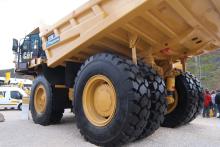
The economic crisis may have helped end the tyre shortage but what impact has the shortage had on tyre use in Europe. Claire Symes reports
"It Is Important to have the premIum new tyres back In the market as It gIve us premIum casIngs for retreadIng"
Rapidly rising demand and a factory fire led to an acute off the highway (OTH) tyre shortage around the world for several years but that ended abruptly this time last year. Increased production capacity combined with reduced demand as a result of the economic slowdown means that tyres are no longer in such short supply.
Nonetheless, the years of shortage have had an impact on tyre usage in quarries and mean many operators are reaping the benefits from reduced operational costs and longer service lives.
"There have been some big changes in the off the road tyre market in recent years with a shortage of tyres," said Marangoni sales manager OTR tyres Luca Mai. "The market was missing lots of premium brand tyres and lots of low cost budget tyres - mainly from Chinese manufacturers - started to appear when it was easy to make in roads into the European market.
"There was simply more demand than supply. New factories and a reduction in demand means that there is now capacity back in the premium market for the future. It will now take the industry two to three months to react rather than two to three years."
Extended life
However, Miguet believes that quarries are now benefitting from extended tyre life as a result of introducing better tyre maintenance and checking procedures during the shortage. "Quarry operators were having to make do with the tyres they had during the supply shortage and many adopted better practises as a result," he said.
"Some operators did turn to cheaper tyre brands, especially from China, during the shortage but there are signs that although money for investment is low, quarries prefer to buy premium tyres to deliver productivity than opt for lower cost brands for short term savings."
Second life
But while many users are making their new tyres work harder for them, some are also more open to the possibilities of a second service life through retreading.
"Retreading currently equates to 25% of the new tyre market in Europe," said Mai. "Growth of this sector is linked to the quality of retreading." Marangoni has a range of retreading to cover the whole of the earthmover market up to 51". The company is the only retreader to cover the whole of Europe - most competitors are only competitors on a national level Marangoni produces its own rubber compound, which Mai said helps it to be sure it is right for the application and also the tread design is suited. "Marangoni works directly for customers in repairing their own tyres but we also buy in worn tyres to retread and supply to the market," he said. "We used specialised dealers to ensure customers get technical advice." The best environmental approach is to retread, according to Mai. "It gives tyres a second life," he said. "It is clear that customers in Europe accept that, but although the main driver for retreading is cost efficiency, the environmental factor is also important." Retreading can deliver 50-60% of the service life of a new tyre and some can even deliver the same service life as new.Puncture proofing
While regular checks can help extend service life, new tyre designs are also helping to reduce the risk of damage and fast track repair if damage does occur. The new double width
The tyre is formed by individual segments, attached to a special wheel that can be used on a number of different wheeled construction machines. AirBoss's Dave Goddard explained, "The biggest advantage is that, unlike current tyre options, if a segment does become damaged beyond repair the operator can easily unscrew the attaching bolt and replace the segment."Nonetheless, Mai is keen to point out that while retreading can offer some customers good cost savings, they cannot directly replace new tyres. "It is important to have the premium new tyres back in the market as it give us premium casings for retreading," he said.
Marangoni offer a five year warranty to give customers confidence, but Mai has said that customers need to choose the right moment to retread carefully. The last point is when there is 10% tread remaining but this is key for traction as well as the potential to retread.
But whether a tyre is new or a retread, Mai said that it is critical to always maintain the right pressure. "Most of the tyres that have to be scrapped are as a result of under inflation," he said.
"Taking care on a regular basis is more cost effective in the long term. End users are now more aware through the shortage of recent years and that is a good thing for them financially and for the environment. It has also driven customers to look for a more cost effective solution than just buying new tyres and that will stand them on good ground in this recession.








